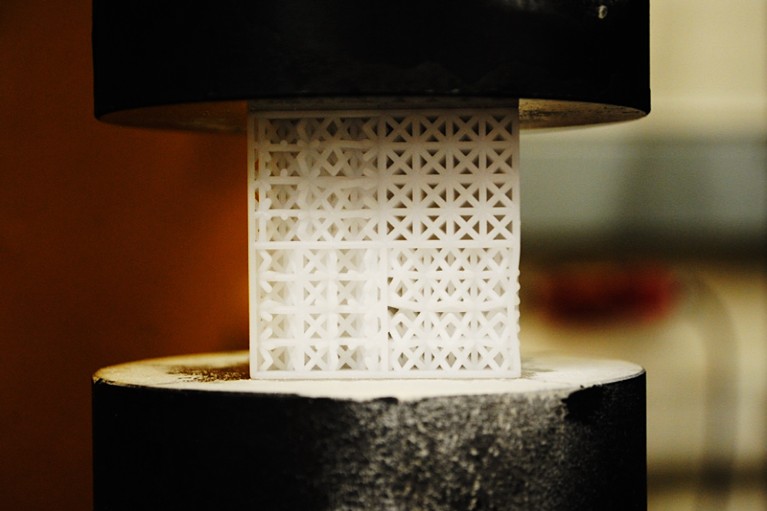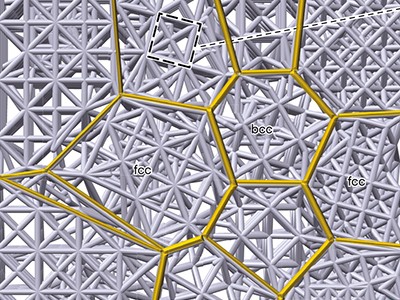
A new generation of 3D printed materials mimic metals.Credit: M.-S. Pham et al./Nature
Astronauts on the International Space Station have had access to an orbiting 3D printer for several years now. But the real advances are being made down on the ground. The technology might be known among the public for turning out trinkets and expensive gifts, but steady progress is also being made in more challenging engineering applications.
Take the fabrication of complex network structures known as architected materials. These 3D structures can be carefully designed to achieve high strength-to-weight ratios compared with those of many conventional solid structures. They require less material than a fully solid structure to achieve similar performance capabilities, making them potentially resource-efficient. And the weight saving means that less energy is required to carry them about, making them intriguing for applications in which energy efficiency is a priority, such as prosthetics or aerospace technology. Such structures are, however, very difficult to fabricate using conventional techniques. And that is where 3D printing — also known as additive manufacturing — comes into play.
Read the paper: Damage-tolerant architected materials inspired by crystal microstructure
In this week’s Nature, scientists at Imperial College London and the University of Sheffield, UK, report how they used 3D printers to create an unusual — and potentially very useful — series of architected materials by borrowing concepts from metallurgy (M.-S. Pham et al. Nature 565, 305–311 (2019)). They deliberately introduce what look like imperfections into 3D-printed plastic and metal lattices, to make them stronger. This strategy mimics on a larger scale the structural and compositional imperfections that can enhance the mechanical performance of normal crystalline materials: the lattice of the architected material stands in for the atomic arrangement in a crystal.
In one class of architected structure, the researchers created a material mimicking a polycrystalline structure — that is, one in which, instead of a single regular lattice structure, the material is broken up into ‘metagrains’ with different lattice orientations. Furthermore, they were able to tune the size of these regions to replicate a known effect in which mechanical strength is controlled by grain size. (In a standard polycrystalline metallic system, it is the boundaries between the grains that hinder material deformation.)
In another approach, the scientists mimicked a technique called precipitation hardening, often used in the manufacture of high-performance alloys. They also studied dual-phase lattices (mimicking steels). They speculate that 3D printing could be used to give structures the same kind of reversible stress-induced phase transformation as is seen in superelastic materials — a desirable property in cases where resilience to, and recovery from, deformation is required.
The authors explored three very different materials for their structures, requiring three different printing technologies. As expected, the properties of these materials were important. Further base materials could be investigated, and other mechanistic approaches for controlling properties are available. The parameter space for future exploration is large.
These demonstrations are just proof of principle; architected materials more generally are still a very new concept. Much work needs to be done before these ideas can be used widely. For example, researchers need to be able to make much larger structures, to exploit the breadth of available engineering materials and to develop design tools that can cater for the complexity of real-world applications.
But 3D printing more generally is now making genuine inroads in manufacturing. Industrial researchers have found additive manufacturing in metals to be appealing because it creates much less waste than does machining sections from a solid block; as such, it is now being used to mass-manufacture a few specific aerospace components. And US aerospace company GE Aviation says it has used additive manufacturing to improve weight efficiency in its new Affinity supersonic jet engine — scheduled to fly in 2023 — making supersonic travel that bit cheaper. As we wrote in a Toolbox article this month, it is also making inroads in the research laboratory (see Nature 565, 123–124; 2019).
It is sometimes said that 3D printing will be a key feature of the fourth industrial revolution, the era of big data, connectivity and human–machine integration. Metallurgy — specifically, developments in iron and steel manufacture — was central to the original Industrial Revolution. Metal endures. And now, architected materials enabled by metallurgical know-how and 3D printing could also go from strength to strength.

 Read the paper: Damage-tolerant architected materials inspired by crystal microstructure
Read the paper: Damage-tolerant architected materials inspired by crystal microstructure
 Five innovative ways to use 3D printing in the laboratory
Five innovative ways to use 3D printing in the laboratory
 Atomic-scale hardening mechanisms apply on larger scales in ‘architected’ materials
Atomic-scale hardening mechanisms apply on larger scales in ‘architected’ materials


